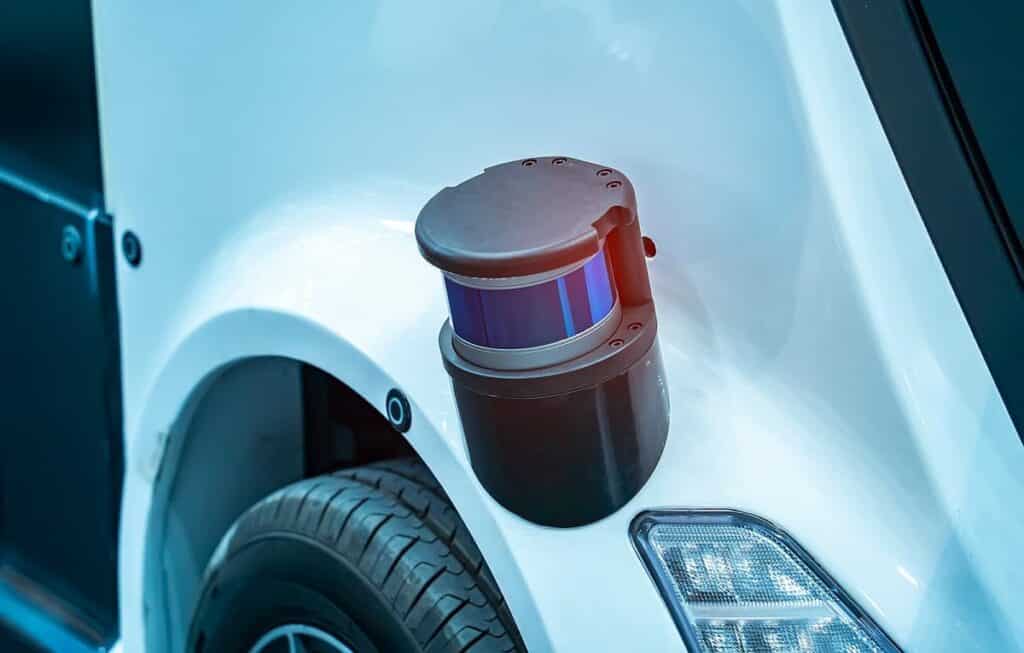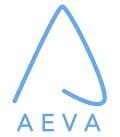8 LiDAR Stocks for Investors to Keep on Their Radar
Table of contents
Table of contents
- Are LiDAR Stocks Worth Investing In?
- Velodyne Stock Still Sees Falling Revenues
- Luminar Technologies Stock Doubles Revenue in 2021
- Aeva Technologies Stock Touts 4D LiDAR Tech
- AEye Stock Still Years Away from Revenue
- Cepton Stock Newest SPAC to Go Public
- Ouster Stock Revenues Driven by Multiple Markets
- Innoviz Stock Continues to Under Deliver
- Quanergy Stock - Last and Least
- Conclusion

Last month, we started our search for a robotics stock to replace the robotics ETF in our Nanalyze Disruptive Tech Portfolio. Intuitive Surgical (ISRG) stock is undoubtedly the best option for investors interested in the robot-assisted surgery theme, but we’re not yet convinced that’s the robotic automation market with the most potential, though there’s plenty of upside when it comes to the market for minimally invasive surgery. We think the grass could be even greener when it comes to self-driving cars. Yes, yes, we know: It’s one of those emerging technologies we’re always waiting for to emerge, outside of some San Francisco techno-hipster enclave where a few startups are testing robotaxis. That’s why we’re interested in a pick-and-shovel stock that would give real exposure to autonomous vehicles now before the big boom. And that’s why we continue to return to the idea of LiDAR stocks.
So far, though, we’ve steered clear of LiDAR stocks since they started to pop up in the public markets in 2020 by merging with special purpose acquisition companies (SPACs). The frenzy over SPACs has largely subsided, and we’re left with eight LiDAR stocks from which to choose. Here’s how they’ve performed since all debuted at the same price – $10 a share.
| Company | Ticker | Price | Performance |
| Luminar Technologies | LAZR | $14.42 | +44% |
| AEye Inc | LIDR | $4.61 | -47% |
| Aeva Technologies | AEVA | $5.52 | -57% |
| Cepton Inc | CPTN | $4.12 | -59% |
| Ouster Inc | OUST | $4.11 | -59% |
| Innoviz Technologies | INVZ | $3.65 | -64% |
| Velodyne Lidar | VLDR | $2.28 | -77% |
| Quanergy | QNGY | $2.02 | -80% |
As beaten down as most these stocks are, we need to watch out for value traps, something we talked about in our recent piece on Avoiding Value Traps in Beaten Down SPACs. Three of these SPACs have pre-SPAC valuation rounds (courtesy of PitchBook) we can compare against today’s valuations.
| Company Name | Round | Valuation (USD Millions) | Date | Market Cap (USD Millions) | Premium / Discount |
| Aeva Technologies | Series B | $400 | Aug-19 | $927 | +132% |
| Innoviz Technologies | Series C | $344 | Jun-19 | $500 | +5% |
| Velodyne Lidar | Series B | $1780 | Dec-18 | $456 | -74% |
While Aeva and Innoviz are trading at a premium to their 2019 venture round valuations, Velodyne’s valuation has dropped nearly 75% since their Series B in late 2018 (more on this in a bit).
When it comes to the largest company by market capitalization, Luminar is currently 5X the size of their nearest competitor, Aeva Technologies, and worth more than all their competitors combined.

That sort of valuation should come with revenues to match, and that’s where things don’t seem to add up. Below we’ve provided three metrics for each SPAC – predicted 2021 revenues, actual 2021 revenues, and percentage difference between the two.
| Company | 2021 Revenue (USD millions) | 2021 Estimate (USD millions) | Difference |
| Luminar | $31.94 | $26 | +23% |
| Aeva | $9.27 | $11 | -16% |
| Aeye | TBD | $4 | N/A |
| Cepton | $4.50 | $4 | +13% |
| Ouster | $33.58 | $34 | -1% |
| Innoviz | $5.47 | $9 | -39% |
| Velodyne Lidar | $61.92 | $152 | -59% |
| Quanergy | $3.9 | $7 | -44% |
Now we start to see why Velodyne Lidar has performed so poorly. The lofty expectations they set in the glossy SPAC deck hardly came true. That was at a time when their revenue growth had slid for four straight years as management assured investors that was all part of some strategic price calibration strategy. It seems there could be some fundamental problems with their business.
One last metric we can look at is our simple valuation ratio to see how these firms are relatively valued.
| Company | Market Cap | Q4-2021 Revenues (USD Millions) | Ratio |
| Luminar | $5,000 | 12.34 | 101 |
| Aeva | 995 | 2.87 | 87 |
| Aeye | 830 | TBD | N/A |
| Cepton | 700 | 1.28 | 137 |
| Ouster | 672 | 11.85 | 14 |
| Innoviz | 489 | 1.66 | 74 |
| Velodyne Lidar | 483 | 17.54 | 7 |
| Quanergy | 169 | TBD | N/A |
According to our calculations, at least half these stocks are overvalued. (We don’t invest in companies that have simple valuation ratios over 40). Are these premiums merited? Let’s try to find out while we search through the LiDAR SPAC wreckage to see if there’s anything worth salvaging.
Are LiDAR Stocks Worth Investing In?
We have a lot of companies to cover, so let’s briefly recap the bull case for LiDAR, which is kind of like radar, except that it uses light waves rather than radio waves to detect objects and map its surroundings. It’s definitely the more accurate technology, but used to be way too expensive to be practical. An early, bulky system from one of the leading companies on our list would cost upwards of $75,000 less than 10 years ago. Now, that same company, Velodyne, recently introduced a LiDAR unit for about $100. That means the technology is now scalable and cost competitive with other sensors like radar and cameras.

The lower costs also mean the technology isn’t just relegated to higher-level autonomous driving systems; they can be added now to more sophisticated advanced driver assistance systems (ADAS) that keep cars on the straight and narrow. Last year, for example, Honda Motor introduced an ADAS with some self-driving capabilities that uses LiDAR as part of its sensor suite. (That’s contrary to what Sir Elon of Musk says – that LiDAR for self-driving cars is “a fool’s errand.”) Outside of AVs, LiDAR use cases include robotics, industrial machinery, and smart infrastructure.
Velodyne Stock Still Sees Falling Revenues
Normally, we’d lead off a list with the most valuable company by market cap. Instead, we’ll start with the least valuable on paper but the one currently leading in revenue that’s nearly double of its next closest competitor. Velodyne was the first LiDAR company we profiled and also the first to go public via SPAC. It also boasts a large portfolio of products that address different markets. For example, its flagship LiDAR, Alpha Prime, has a range of nearly 1,000 feet that is capable of real-time high-res perception at highway speeds. Compare that to a solid-state LiDAR with no moving parts called the Velarray M1600 that’s designed for mobile robots delivering pizza to stoners too paranoid to leave home.
The thing about Velodyne is that revenues have been steadily dropping on purpose, because the company is scaling the technology quickly to accelerate adoption. Velodyne actually warned investors revenues would decrease for a few years as the average selling price of its products dropped. However, 2021 was supposed to be when revenues started to rebound to reach $152 million. Well, revenues continued to go south and fell $90 million short of that SPAC-hyped projection from a couple of years ago. One thing holding Velodyne and the rest of the industry back is that many of its customers are still in the pre-commercial stage.

Some bright spots: The company says an increase in product volume is off-setting losses from lower average selling prices, and Velodyne actually increased quarterly revenues in Q4-2021 from the previous quarter for the first time in a while. That’s especially relevant given that the company generates more than half of its income from sales in non-automotive applications, including “autonomous mobile robots, UAVs, drones, last-mile delivery, precision agriculture, advanced security systems, and smart city initiatives.” Velodyne is geographically diverse, with less than half of revenue coming from North America, though the United States does account for 35% of all revenues.
The question remains whether Velodyne can eventually grow revenues as promised against a stiff field of competition. The answer is definitely not until they clean up the dirty laundry they’ve been airing for the world to see. When the founder of Velodyne, who also happens to be the largest shareholder, puts up a website called “Save Velodyne” and begs investors to oust Velodyne’s Chairman of the Board who (according to the company website) is also their Chief Financial Officer, you’re best served avoiding that baby mama drama. Some of the allegations are astounding, and we want nothing to do with a company that’s undergoing that degree of turmoil with their biggest investor.
Luminar Technologies Stock Doubles Revenue in 2021
Topping our LiDAR SPAC list is Luminar Technologies, a $5 billion company that more than doubled revenue to $32 million last year. That’s actually better than the SPAC deck promised when we published our original article. The company said two factors increased revenue: a 142% increase in revenue from customization/non-recurring engineering services and a 177% increase in sales of sensors. Obviously, the latter number becomes more important as the technology scales.
Speaking of the technology: Unlike Velodyne, Luminar only has one primary LiDAR: The company is currently transitioning from its Hydra model to Iris, which leverages the same core technology but sounds more commercial scale-ready in terms of size, performance, and cost. Volvo is using Iris in a new vehicle that will feature some level of AV capability for hands-free driving while taking dick pics. Luminar is teaming up with the same company behind Volvo’s automation software, a Swedish spin-out from the automaker called Zenseact, to offer a full-stack automation solution. The Sentinel system, however, is still in the development phase.

The company promises revenue of more than $40 million this year, which still gels with its original projections, especially if a new partnership with Mercedes-Benz works out. Luminar had more than $300 million left in cash at the end of last year, so there’s plenty of room to run as it looks to capture more market share.
Aeva Technologies Stock Touts 4D LiDAR Tech
Sporting a market cap just south of $1 billion and less than 10 million in revenue, Aeva Technologies just released its first fully commercial LiDAR this year called the Aires II. Most of its revenue up until now have been products for pilot testing. The company touts Aires II as the world’s only 4D LiDAR, featuring something called Frequency Modulated Continuous Wave technology that allows it to measure velocity in addition to depth, reflectivity, and inertial motion. The result is a LiDAR that is reportedly 20 times the resolution of other LiDAR sensors, with a range of up to 1,500 feet. All key components are incorporated into a single compact chip module for automated mass production.

One recent win for the company was getting the Aires II onto the NVIDIA DRIVE autonomous vehicle platform to develop, train, test and validate safe self-driving technology at scale.
AEye Stock Still Years Away from Revenue
Sporting a market cap even further south of $1 billion and negligible revenues of just over $1 million for the first three quarters of 2021, AEye is an Irish company (one of the few not based around Silicon Valley) developing a LiDAR system that leans heavily on AI (as you might expect, based on the name) to do a lot of the heavy lifting. Dubbed iDAR, for Intelligent Detection and Ranging, the platform combines LiDAR, cameras, and what the company calls “integrated deterministic artificial intelligence” to capture “more intelligent information with less data, enabling faster, more accurate, and more reliable perception.” AEye’s business seems to depend heavily on a partnership with Continental (CON.DE), a German automotive parts manufacturer, which will license and manufacture the system.

The deal is based on a memorandum of agreement, which isn’t much better than a pinky swear in most cases. Commercialization is expected to begin in 2024 so don’t expect much revenue action before then.
Cepton Stock Newest SPAC to Go Public
Cepton Inc is the latest SPAC to go public. The stock is already down 50% since it premiered on the Nasdaq back on Feb 10, after briefly and inexplicably shooting up to $42 a share a week after ringing the opening bell. Like AEye, Cepton relies on a third-party company, Koito Manufacturing (7276.T), to license and manufacture its LiDAR, a solid state system using something called micro-motion technology (MMT). At least one significant difference between MMT and many other LiDARs that use micro-electro-mechanical systems is the laser beam steering mechanism, according to various sources. The MMT uses some sort of amplified vibrational technique:

Cepton has reportedly inked a deal with GM to start supplying its LiDAR for as many as nine models beginning next year.
Ouster Stock Revenues Driven by Multiple Markets
Ouster Inc is the only other LiDAR stock on this list with significant revenue at $34 million, representing sales of nearly 6,500 sensors, which is more than half of the total number of units the company has shipped to date. The company claims it had 600 customers in 2021, up from about 500 the year before, with no single customer accounting for more than 10% of revenues. Automotive only accounts for about a third of sensors shipped, with industrial (think heavy machinery like tractors) accounting for 25%, robotics another 26%, and smart infrastructure (mainly mobility applications) the other 15%. Its tech is based on a digital LiDAR system that uses a custom system-on-a-chip that “replaces the functionality of hundreds of discrete analog components and integrates those capabilities” onto a single complementary chip.

Ouster expects to double revenue this year between $65 million and $85 million, with gross margins ranging between 25% and 30%. Those sort of numbers could see it surpass both Velodyne and Luminar. With a simple valuation ratio of 14, we wouldn’t consider it to be overvalued when compared to half the LiDAR companies on this list.
Innoviz Stock Continues to Under Deliver
Innoviz Technologies is an Israeli company that we’ve watched since 2017 as one of many LiDAR startups at the time. Innoviz was supposed to introduce a $100 solid-state LiDAR (meaning no moving parts) in 2018. Four years later, the company reported all of $5.5 million in 2021 (a number 39% below SPAC estimates), so obviously it hasn’t hit critical mass yet. The latest press releases and Q4 investor deck touts things like five new pre-production deals, which are basically pilot projects. For example, a Japanese construction company will test out Innoviz’s LiDAR for autonomous crane operations. However, as far as we can tell, the company has yet to score a significant commercial deal that’s lead to meaningful revenues or offer a $100 LiDAR. That puts it at the bottom of the list in market cap and competitiveness.
Quanergy Stock – Last and Least
With a market cap of $169 million, Quanergy is almost too small to even spend time talking about. We don’t invest in companies with a market cap of less than $1 billion, so nearly all the companies we’ve discussed today are disqualified based on that criteria alone. The smaller a company becomes, the more difficult everything becomes – like raising money. Quanergy left their SPAC deal with “$50 million in cash, and $125 million in committed funding” as opposed to the $278 million in cash they had once hoped for. An article by Optics.org puts Quanergy’s 2021 revenues at $3.9 million, a number which is too small to be considered meaningful. It goes on to say that Quanergy “lost a case it brought against the validity of patents owned by competitor Velodyne,” so not a big vote of confidence for their intellectual property portfolio.
Conclusion
Unlike Intuitive Surgical in robot-assisted surgery, there’s no clear leader among LiDAR stocks, just some that are a little further along than others. This market is more like the commercial NewSpace industry, which is also dominated by former SPAC-based companies. It was also tough to find a space company to finally invest in, and the options are far more diverse (e.g., rockets, satellites, space stations) than just eight variations on the same kind of technology. At this point, it’s difficult to evaluate which ones will emerge as frontrunners in not just automotive markets, but robotics, smart infrastructure, industrial, and more.
Finally, we want to circle back around to where we started with our reference to Intuitive Surgical being a safe, steady bet versus the explosive potential for LiDAR to support these different industries. There’s a rough consensus out there – “out there” being the $5,000 market reports we never buy, just read the press releases – that the LiDAR market will grow to somewhere near $6 billion sometime before the end of this decade. That’s about how much revenue ISRG brought in last year. The LiDAR market may simply be too small right now for retail investors to bother. It may be worth checking back in a couple of years after a leader or two has established itself.
Sign up to our newsletter to get more of our great research delivered straight to your inbox!
Nanalyze Weekly includes useful insights written by our team of underpaid MBAs, research on new disruptive technology stocks flying under the radar, and summaries of our recent research. Always 100% free.























More focus is needed on the stocks that could be a possible profitable investment at this particular time.
Eg: in the last couple of years there were 2 incredibly successful disruptive technology stocks: Tesla (TSLA) and Enphase Energy (ENPH).
Since 2019 Tesla increased from $63 to over $1,010 now (but it was over $1222 in November) – gain +1,503%.
Since 2019 Enphase Energy increased from $5 to $193.08 now (but it was over $267 in November) – gain +3,760%.
I am puzzed why none of them had a proper article here ..
You are covering many obscure stocks where you say they are not good investments, while at the same time ignoring the biggest winners.
We don’t invest in stocks with a market cap of less than $1 billion, so many stocks on this list aren’t on our radar until they exit the death zone.
We can point to dozens of stocks that had massive returns we haven’t covered. The stocks we cover and the reasons we have for covering them have been documented over the past seven years. No other stock out there is covered more than Tesla, so don’t expect us to jump on that bandwagon. Our commentary on Tesla is in our Disruptive Tech Report and Tech Stock Catalog. As for Enphase, they’re on our list to take a look at in the coming weeks but you’re probably not going to like what we have to say about them. Chasing performance never makes sense.
I must put in my two cents. Author stated that Aeye is an Irish company? Not in silicon Valley?
First off… company is in the East Bay of NorCal. Second… Others boast Lidars with range of 1500 feet? 10x that & you got Aeye. Third… speed at which Aeye processes info is well..do your hw. Something i think quite important when it comes to driving and “rreflex tech”. Feel free to Google their website. Fourth… last time I checked, my brother was latino.
The author was taking the piss out of the fact they live in Dublin California. We inject humor whenever possible to make the reading experience more enjoyable 😉
That’s great Aeye has superior technology, but it all comes down to what customers are willing to pay for. They told us $13 million for 2022 revenues in the SPAC deck and now “the Company is targeting $4 million to $6 million of revenues in 2022.” Absolute rubbish. And they missed their 2021 estimate too. A management team that breaks promises is a huge red flag. Yes, we’ve looked at their website. What we focus on is results. Didn’t get the “my brother is latino” reference but we always appreciate snark! 🙂
“There’s a rough consensus out there – “out there” being the $5,000 market reports we never buy, just read the press releases – that the LiDAR market…”
This! This made my day.
I love your content and the research and admittedly also the subtle humor you guys sprinkle in. In this – currently – grim world this is much appreciated.
Thank you very much for taking the time to leave positive feedback and encouragement. A great deal of financial commentary is so dry you need a glass of water to read it. We try to make things a bit more enjoyable for the reader while having some fun ourselves.
“Volvo is using Iris in a new vehicle that will feature some level of AV capability for hands-free driving while taking dick pics.“
Was this sentence a mistype or was the intent to actually refer to hands-free driving while taking dick pics lol? I’m genuinely curious.
We like to put in Easter eggs to make sure people are actively reading. Nobody else takes dick pics while driving?
I like your deep looking research, even if most time you tell me do not invest. Thank you for this! Do you have any idea regarding Arbe Robotics, wich is engaged as well in this field?
We never tell you not to invest, we only tell you what we decide to do 😉 And we’re glad you’re finding our research useful nonetheless.
Good question on Arbe Robotics – we briefly covered them here: https://nanalyze.com/2021/05/disruptive-technology-spacs/
They are barely realizing any revenues right now so not sure (especially with their small size) it would be a firm we would profile. Admittedly, we could have included them in this list but they were overlooked when we were vetting names.
I am a young and upcoming Cameroonian from Africa seeking to invest in small cap stocks that have very high potentials within the next 5 years. Really need help, am interested in AI technology, lidar, electric charging ports, lithium battery production companies. A way forward will be what I need now. Kindly guide me on the right part to a better choice.
You came to the right place. We have over 2,300 research pieces to help guide you.